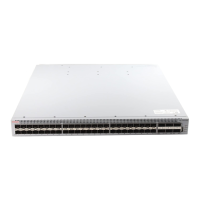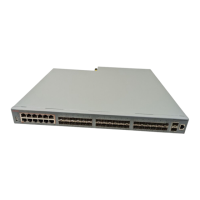Rear port mode
By default, the Fabric Interconnect (FI) ports on the rear of the VSP 7000 Series are configured for
Stack-mode Distributed Top-of-Rack deployments, leveraging the Flexible Advanced Stacking
Technology (FAST) protocol. When you enable rear port mode, the unit reboots and reconfigures
the FI ports as multiple 40 gigabit per second Avaya interface ports for use with other protocols. You
can use rear port mode to interconnect multiple stand-alone VSP 7000 units using FI cables.
Depending on the rear port mode of operation, either seven or eight 40 Gbps interfaces are
available over the four FI ports on the rear of the switch.
The following table provides detailed information about the FI ports and rear port modes:
FI port Rear port mode Bandwidth Port interface
UP 1 (right top
connector)
Standard (Raw-mode) 120 Gbps 34, 35, 36
UP 2 (right bottom
connector)
Standard (Raw-mode) 40 Gbps 33
DOWN 1 (left top
connector)
Standard (Raw-mode) 120 Gbps 38, 39, 40
DOWN 2 (left bottom
connector)
Standard (Raw-mode) 40 Gbps 37
UP 1 (right top
connector)
SPB (Fabric-mode
DToR)
120 Gbps 34, 35, 36
UP 2 (right bottom
connector)
SPB (Fabric-mode
DToR)
40 Gbps 33
DOWN 1 (left top
connector)
SPB (Fabric-mode
DToR)
80 Gbps 38, 39
DOWN 2 (left bottom
connector)
SPB (Fabric-mode
DToR)
40 Gbps 37
On the rear of each VSP 7000 Series unit is a pair of FI-up and FI-down ports. In each FI port pair
there is a top and bottom connector. In rear port mode, each top connector can provide up to three
40 Gbps ports, and each bottom connector can provide one 40 Gbps port.
You can enable a rear port mode and connect the FI ports between stand-alone VSP 7000 Series
units to deploy in a Fabric-mode Distributed Top-of-Rack (DToR) or Raw-mode configuration.
Fabric-mode DToR leverages the Shortest Path Bridging (SPB) protocol. Standard is a Raw-mode,
that can support various port configurations and protocols, such as Inter-Switch Trunking (IST) for
Switch Clustering.
Note:
Due to the different bandwidth support of the FI port top and bottom connectors, you must
connect the top connector to the top connector of another unit, and connect the bottom
connector to the bottom connector of another unit.
Rear port mode is disabled by default. With rear port mode disabled, the FI ports on the rear of the
chassis can be interconnected between units to deploy in a Stack-mode DToR.
Rear port mode
August 2014 Installing Avaya VSP 7000 Series 45
Comments? infodev@avaya.com

